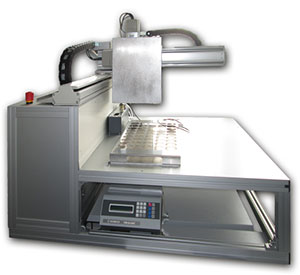Many laboratories are using Automatic Particle Counters to determine the solid contamination within their fluid samples. In most cases, standard sample systems are sufficient for everyday laboratory measurements. Difficulties arise when a high quantity of samples are required daily.
Standard systems cannot cope with the sheer volume of samples, so laboratories analysing these very large numbers are forced to use multiple systems in parallel. This creates a higher cost for the companies and the numerous units use up a larger amount of space.
For laboratories with high sample quantities, PAMAS has designed the new PAMAS AS3 autosampling system. The system incorporates an automatic measuring process, so that several hundred samples can be analysed per day. Compared to previous versions, the new PAMAS AS3 autosampler comprises of improved key features in relation to reliability, sample preparation, sample handling, flushing and sample diluton.
 The newly developed PAMAS AS3 autosampling system analyses several hundred samples per day with unattended operation.
The newly developed PAMAS AS3 autosampling system analyses several hundred samples per day with unattended operation.
The new autosampling system PAMAS AS3 is designed to provide sample analysis of several hundred samples per day, with unattended operation. The development of this new product was formed around the feedback PAMAS received from users of existing PAMAS autosamplers and also from the requirements of potential customers. Based on these requests, the new autosampler PAMAS AS3 now includes all the necessary requirements that have been brought forward from the users and offers new features in relation to reliability, sample preparation, sample handling, flushing and sample dilution.
Reliability
System reliability and trouble free operation are considered by staff operators as the two most important features for automatic particle counters. Global and uncommitted availability of components is a prerequisite for system reliability. The PAMAS AS3 system is built using high quality components that are readily available.
A short delivery time worldwide is essential to maintain the operation of the system. To ensure availability of parts, manufacturers of worldwide available parts were chosen. All service personnel maintaining these systems will require training at a PAMAS facility to ensure a com¬petent service of the system can be maintained at any location, worldwide.
Sample preparation
The new PAMAS AS3 system includes a sample preparation probe that breaks all agglomerates in the fluid before analysis. The ultrasonic probe is located on the robot and prepares the subsequent sample whilst the current sample is being analysed. The sample preparation device is cleaned between samples to minimise cross contamination.
Sample handling
The new system has a XYZ stage, operating with samples on trays as these are the most widely used method in high quantity laboratories. RFID (Radio Frequency Identification) or barcode systems can be used optionally to automatically identify the trays.
The system can be linked to an existing LIM (Laboratory Information Management) system. If the existing LIM system can forward sample IDs based on tray number and X/Y position within the tray, no individual sample identification procedure is necessary.
If the samples carry RFID or barcode labels, samples can be identified with an attached reader. Sample identification enables correct handling of individual samples. A close link to the LIM system helps to request information about samples. It is possible to transfer special condition options for samples using the LIM system. For example the LIM system can be set up for “necessary dilution factor 9:1” or “average value of the last five results”. The new autosampler PAMAS AS3 handles this information accordingly.
The system can be built to match existing trays. Large systems with several hundred samples to analyse, allow continuous unattended operation (three shifts within 24 hours).
The system is servo motor driven. This increases the speed of operation and reduces the noise level below that of stepper motors.
The system table has an integrated drain trap that collects any spillage. A drainage system can be connected to feed the spillage to a central collection system.
Flushing
The new PAMAS AS3 autosampling system is equipped with an intelligent flushing device which optimises the sequence of samples.
Sample dilution
Some samples may either be too dirty or too viscous or may contain undissolved additives or undissolved water. In this case, sample dilution with low viscous solvents helps to get reliable measuring results. The new system has an automatic dilution system that adds a programmable amount of solvent online to the raw sample. The system’s inner structural design ensures that the solvent and sample fluid are thoroughly mixed.
The new PAMAS AS3 utilises current superior advanced PAMAS sensor technology and features all relevant requests for improvement that have been brought forward from users.
Further information on PAMAS AS3 and on the full PAMAS product line is available at the company’s website www.pamas.de.